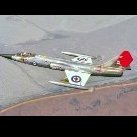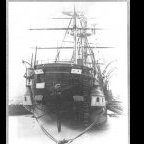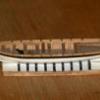Supplies of the Ship Modeler's Handbook are running out. Get your copy NOW before they are gone! Click on photo to order.
×

Charter33
-
Posts
454 -
Joined
-
Last visited
Reputation Activity
-
 Charter33 reacted to Yabuhebi in HMS Victory by Yabuhebi (Chris) - Caldercraft - 1:72
Charter33 reacted to Yabuhebi in HMS Victory by Yabuhebi (Chris) - Caldercraft - 1:72
An hour here, an hour there!
I blackened the cannons and all of the various bits that are attached to the cannon bases. It's a love hate result.
I think you have to polish the finished result with a clean cloth, but doing so will rub off some of the black, which will require you to dip them again.
Now pictures, as always will enhance the reality these are miniatures (built by a rookie) and will enhance my flaws.
But from farther away, they look fine.
Drilling the holes for the various eyelets is tough. .5mm bits are very thin and if you are not careful, you will break them, I think I started with 5 or 6 of them and they are all gone!!!
Also, the directions require a .7mm hole for the bolts that hold the trunnions in place. It was almost impossible to do this with any precision.
I have a drill press and suppose I could have rigged that up and secured each cannon base in place....I didn't bother.
My thinking is that once painted, they blend in. Once I am done creating the 10 showcase cannons I might consider cutting the heads off the pins that were meant to hold the trunnions in place and just glue them in the holes for the aesthetics of it all!
I did have to touch up the cannon breeches because the blackening agent doesn't work on CA glue, but I knew that was going to happen.
To be honest, for those that want to go with a paint option, the dried result looks great and I would guess that painting the cannons and ensuring they are drip free will look just fine!
The forward eyelets are there to hold a ring that the breeching rope runs through as it goes from the bulkhead wall to the cannon, around the back and back through a ring on the other side on its way to the other side and bulkhead. I have a way to make rings, just not sure yet what size wire to use. The wire I used to make the breeching loops is just too thick. I think I have some very thin brass wire. I'll keep you posted.
I also installed the 3 crooked ladders I made in addition to adding the lower stanchions for the rope railings. That was a bit tough to do because of the angle of the stairs in relation to the upright angle needed for the stanchion. Also, trying to guesstimate how much thread to leave for the finished railings was tough. Hopefully I guessed right!
Oh yes, the manual asks for .25mm thread for the rope railings. Once blackened or even painted, there is NO WAY to get a thread that thick through the stanchion holes. That is where I broke my last .25mm drill trying. So I am using the .1mm thread....at least for these railings that are a but lower.
Perhaps I will see what I can do to the stanchions for the next deck BEFORE I remove them from the sprue.
-
 Charter33 got a reaction from CiscoH in Woodwork/Model making workshop by Charter33 - FINISHED - Scale 1:1
Charter33 got a reaction from CiscoH in Woodwork/Model making workshop by Charter33 - FINISHED - Scale 1:1
I decided to go ahead with my original plan and used the pieces of cladding I had already prepared to trial the idea on the far end wall.
'Loose tongues' keep the ends of the boards level where joints don't line up with the timber frames. The width of the cladding strips vary between runs, and the run that follows the line of the sockets is only temporarily tacked in place so that it can be removed to permit the installation of the ring main cable.
I'm focusing on the ceiling next and am currently converting those scaffold boards used as shuttering for the concrete base.
Thinking of possibly giving the internal cladding a 'limed' or whitewash effect finish that makes a feature of the wood grain. This will then be coated with satin or matt varnish. We'll see...
Cheers,
Graham.
-
 Charter33 got a reaction from bobandlucy in Woodwork/Model making workshop by Charter33 - FINISHED - Scale 1:1
Charter33 got a reaction from bobandlucy in Woodwork/Model making workshop by Charter33 - FINISHED - Scale 1:1
I decided to go ahead with my original plan and used the pieces of cladding I had already prepared to trial the idea on the far end wall.
'Loose tongues' keep the ends of the boards level where joints don't line up with the timber frames. The width of the cladding strips vary between runs, and the run that follows the line of the sockets is only temporarily tacked in place so that it can be removed to permit the installation of the ring main cable.
I'm focusing on the ceiling next and am currently converting those scaffold boards used as shuttering for the concrete base.
Thinking of possibly giving the internal cladding a 'limed' or whitewash effect finish that makes a feature of the wood grain. This will then be coated with satin or matt varnish. We'll see...
Cheers,
Graham.
-
 Charter33 got a reaction from mtaylor in Woodwork/Model making workshop by Charter33 - FINISHED - Scale 1:1
Charter33 got a reaction from mtaylor in Woodwork/Model making workshop by Charter33 - FINISHED - Scale 1:1
I decided to go ahead with my original plan and used the pieces of cladding I had already prepared to trial the idea on the far end wall.
'Loose tongues' keep the ends of the boards level where joints don't line up with the timber frames. The width of the cladding strips vary between runs, and the run that follows the line of the sockets is only temporarily tacked in place so that it can be removed to permit the installation of the ring main cable.
I'm focusing on the ceiling next and am currently converting those scaffold boards used as shuttering for the concrete base.
Thinking of possibly giving the internal cladding a 'limed' or whitewash effect finish that makes a feature of the wood grain. This will then be coated with satin or matt varnish. We'll see...
Cheers,
Graham.
-
 Charter33 got a reaction from Javlin in Woodwork/Model making workshop by Charter33 - FINISHED - Scale 1:1
Charter33 got a reaction from Javlin in Woodwork/Model making workshop by Charter33 - FINISHED - Scale 1:1
I decided to go ahead with my original plan and used the pieces of cladding I had already prepared to trial the idea on the far end wall.
'Loose tongues' keep the ends of the boards level where joints don't line up with the timber frames. The width of the cladding strips vary between runs, and the run that follows the line of the sockets is only temporarily tacked in place so that it can be removed to permit the installation of the ring main cable.
I'm focusing on the ceiling next and am currently converting those scaffold boards used as shuttering for the concrete base.
Thinking of possibly giving the internal cladding a 'limed' or whitewash effect finish that makes a feature of the wood grain. This will then be coated with satin or matt varnish. We'll see...
Cheers,
Graham.
-
 Charter33 got a reaction from Roger Pellett in Woodwork/Model making workshop by Charter33 - FINISHED - Scale 1:1
Charter33 got a reaction from Roger Pellett in Woodwork/Model making workshop by Charter33 - FINISHED - Scale 1:1
I decided to go ahead with my original plan and used the pieces of cladding I had already prepared to trial the idea on the far end wall.
'Loose tongues' keep the ends of the boards level where joints don't line up with the timber frames. The width of the cladding strips vary between runs, and the run that follows the line of the sockets is only temporarily tacked in place so that it can be removed to permit the installation of the ring main cable.
I'm focusing on the ceiling next and am currently converting those scaffold boards used as shuttering for the concrete base.
Thinking of possibly giving the internal cladding a 'limed' or whitewash effect finish that makes a feature of the wood grain. This will then be coated with satin or matt varnish. We'll see...
Cheers,
Graham.
-
 Charter33 got a reaction from thibaultron in Woodwork/Model making workshop by Charter33 - FINISHED - Scale 1:1
Charter33 got a reaction from thibaultron in Woodwork/Model making workshop by Charter33 - FINISHED - Scale 1:1
I decided to go ahead with my original plan and used the pieces of cladding I had already prepared to trial the idea on the far end wall.
'Loose tongues' keep the ends of the boards level where joints don't line up with the timber frames. The width of the cladding strips vary between runs, and the run that follows the line of the sockets is only temporarily tacked in place so that it can be removed to permit the installation of the ring main cable.
I'm focusing on the ceiling next and am currently converting those scaffold boards used as shuttering for the concrete base.
Thinking of possibly giving the internal cladding a 'limed' or whitewash effect finish that makes a feature of the wood grain. This will then be coated with satin or matt varnish. We'll see...
Cheers,
Graham.
-
 Charter33 got a reaction from Canute in Woodwork/Model making workshop by Charter33 - FINISHED - Scale 1:1
Charter33 got a reaction from Canute in Woodwork/Model making workshop by Charter33 - FINISHED - Scale 1:1
I decided to go ahead with my original plan and used the pieces of cladding I had already prepared to trial the idea on the far end wall.
'Loose tongues' keep the ends of the boards level where joints don't line up with the timber frames. The width of the cladding strips vary between runs, and the run that follows the line of the sockets is only temporarily tacked in place so that it can be removed to permit the installation of the ring main cable.
I'm focusing on the ceiling next and am currently converting those scaffold boards used as shuttering for the concrete base.
Thinking of possibly giving the internal cladding a 'limed' or whitewash effect finish that makes a feature of the wood grain. This will then be coated with satin or matt varnish. We'll see...
Cheers,
Graham.
-
 Charter33 got a reaction from Haliburton in Woodwork/Model making workshop by Charter33 - FINISHED - Scale 1:1
Charter33 got a reaction from Haliburton in Woodwork/Model making workshop by Charter33 - FINISHED - Scale 1:1
I decided to go ahead with my original plan and used the pieces of cladding I had already prepared to trial the idea on the far end wall.
'Loose tongues' keep the ends of the boards level where joints don't line up with the timber frames. The width of the cladding strips vary between runs, and the run that follows the line of the sockets is only temporarily tacked in place so that it can be removed to permit the installation of the ring main cable.
I'm focusing on the ceiling next and am currently converting those scaffold boards used as shuttering for the concrete base.
Thinking of possibly giving the internal cladding a 'limed' or whitewash effect finish that makes a feature of the wood grain. This will then be coated with satin or matt varnish. We'll see...
Cheers,
Graham.
-
 Charter33 got a reaction from Keith Black in Woodwork/Model making workshop by Charter33 - FINISHED - Scale 1:1
Charter33 got a reaction from Keith Black in Woodwork/Model making workshop by Charter33 - FINISHED - Scale 1:1
Three phrases that bring stress onto your life:
'When you've got a minute...'
'While you're out there...'
'Could you just...'
🤣🤣🤣
-
 Charter33 got a reaction from Gregory in Woodwork/Model making workshop by Charter33 - FINISHED - Scale 1:1
Charter33 got a reaction from Gregory in Woodwork/Model making workshop by Charter33 - FINISHED - Scale 1:1
I decided to go ahead with my original plan and used the pieces of cladding I had already prepared to trial the idea on the far end wall.
'Loose tongues' keep the ends of the boards level where joints don't line up with the timber frames. The width of the cladding strips vary between runs, and the run that follows the line of the sockets is only temporarily tacked in place so that it can be removed to permit the installation of the ring main cable.
I'm focusing on the ceiling next and am currently converting those scaffold boards used as shuttering for the concrete base.
Thinking of possibly giving the internal cladding a 'limed' or whitewash effect finish that makes a feature of the wood grain. This will then be coated with satin or matt varnish. We'll see...
Cheers,
Graham.
-
 Charter33 got a reaction from Keith Black in Woodwork/Model making workshop by Charter33 - FINISHED - Scale 1:1
Charter33 got a reaction from Keith Black in Woodwork/Model making workshop by Charter33 - FINISHED - Scale 1:1
I decided to go ahead with my original plan and used the pieces of cladding I had already prepared to trial the idea on the far end wall.
'Loose tongues' keep the ends of the boards level where joints don't line up with the timber frames. The width of the cladding strips vary between runs, and the run that follows the line of the sockets is only temporarily tacked in place so that it can be removed to permit the installation of the ring main cable.
I'm focusing on the ceiling next and am currently converting those scaffold boards used as shuttering for the concrete base.
Thinking of possibly giving the internal cladding a 'limed' or whitewash effect finish that makes a feature of the wood grain. This will then be coated with satin or matt varnish. We'll see...
Cheers,
Graham.
-
 Charter33 got a reaction from Old Collingwood in Woodwork/Model making workshop by Charter33 - FINISHED - Scale 1:1
Charter33 got a reaction from Old Collingwood in Woodwork/Model making workshop by Charter33 - FINISHED - Scale 1:1
I decided to go ahead with my original plan and used the pieces of cladding I had already prepared to trial the idea on the far end wall.
'Loose tongues' keep the ends of the boards level where joints don't line up with the timber frames. The width of the cladding strips vary between runs, and the run that follows the line of the sockets is only temporarily tacked in place so that it can be removed to permit the installation of the ring main cable.
I'm focusing on the ceiling next and am currently converting those scaffold boards used as shuttering for the concrete base.
Thinking of possibly giving the internal cladding a 'limed' or whitewash effect finish that makes a feature of the wood grain. This will then be coated with satin or matt varnish. We'll see...
Cheers,
Graham.
-
 Charter33 got a reaction from AJohnson in Woodwork/Model making workshop by Charter33 - FINISHED - Scale 1:1
Charter33 got a reaction from AJohnson in Woodwork/Model making workshop by Charter33 - FINISHED - Scale 1:1
A big thank you for all the 'likes' and advice I've received.
Summer has final arrived with the local weather producing temperatures in line with those expected in June. The opening porthole, together with the single opening roof light, and now with the insulation in place, have produced a very comfortable working environment. There's definitely a light and airy feel to the place, especially in the end that will be dedicated to model making. Getting there slowly..... the end is in sight now
-
 Charter33 got a reaction from Jack12477 in Woodwork/Model making workshop by Charter33 - FINISHED - Scale 1:1
Charter33 got a reaction from Jack12477 in Woodwork/Model making workshop by Charter33 - FINISHED - Scale 1:1
I decided to go ahead with my original plan and used the pieces of cladding I had already prepared to trial the idea on the far end wall.
'Loose tongues' keep the ends of the boards level where joints don't line up with the timber frames. The width of the cladding strips vary between runs, and the run that follows the line of the sockets is only temporarily tacked in place so that it can be removed to permit the installation of the ring main cable.
I'm focusing on the ceiling next and am currently converting those scaffold boards used as shuttering for the concrete base.
Thinking of possibly giving the internal cladding a 'limed' or whitewash effect finish that makes a feature of the wood grain. This will then be coated with satin or matt varnish. We'll see...
Cheers,
Graham.
-
 Charter33 got a reaction from AJohnson in Woodwork/Model making workshop by Charter33 - FINISHED - Scale 1:1
Charter33 got a reaction from AJohnson in Woodwork/Model making workshop by Charter33 - FINISHED - Scale 1:1
I decided to go ahead with my original plan and used the pieces of cladding I had already prepared to trial the idea on the far end wall.
'Loose tongues' keep the ends of the boards level where joints don't line up with the timber frames. The width of the cladding strips vary between runs, and the run that follows the line of the sockets is only temporarily tacked in place so that it can be removed to permit the installation of the ring main cable.
I'm focusing on the ceiling next and am currently converting those scaffold boards used as shuttering for the concrete base.
Thinking of possibly giving the internal cladding a 'limed' or whitewash effect finish that makes a feature of the wood grain. This will then be coated with satin or matt varnish. We'll see...
Cheers,
Graham.
-
 Charter33 got a reaction from Egilman in Woodwork/Model making workshop by Charter33 - FINISHED - Scale 1:1
Charter33 got a reaction from Egilman in Woodwork/Model making workshop by Charter33 - FINISHED - Scale 1:1
I decided to go ahead with my original plan and used the pieces of cladding I had already prepared to trial the idea on the far end wall.
'Loose tongues' keep the ends of the boards level where joints don't line up with the timber frames. The width of the cladding strips vary between runs, and the run that follows the line of the sockets is only temporarily tacked in place so that it can be removed to permit the installation of the ring main cable.
I'm focusing on the ceiling next and am currently converting those scaffold boards used as shuttering for the concrete base.
Thinking of possibly giving the internal cladding a 'limed' or whitewash effect finish that makes a feature of the wood grain. This will then be coated with satin or matt varnish. We'll see...
Cheers,
Graham.
-
 Charter33 got a reaction from king derelict in Woodwork/Model making workshop by Charter33 - FINISHED - Scale 1:1
Charter33 got a reaction from king derelict in Woodwork/Model making workshop by Charter33 - FINISHED - Scale 1:1
I decided to go ahead with my original plan and used the pieces of cladding I had already prepared to trial the idea on the far end wall.
'Loose tongues' keep the ends of the boards level where joints don't line up with the timber frames. The width of the cladding strips vary between runs, and the run that follows the line of the sockets is only temporarily tacked in place so that it can be removed to permit the installation of the ring main cable.
I'm focusing on the ceiling next and am currently converting those scaffold boards used as shuttering for the concrete base.
Thinking of possibly giving the internal cladding a 'limed' or whitewash effect finish that makes a feature of the wood grain. This will then be coated with satin or matt varnish. We'll see...
Cheers,
Graham.
-
 Charter33 got a reaction from kiwiron in Woodwork/Model making workshop by Charter33 - FINISHED - Scale 1:1
Charter33 got a reaction from kiwiron in Woodwork/Model making workshop by Charter33 - FINISHED - Scale 1:1
I decided to go ahead with my original plan and used the pieces of cladding I had already prepared to trial the idea on the far end wall.
'Loose tongues' keep the ends of the boards level where joints don't line up with the timber frames. The width of the cladding strips vary between runs, and the run that follows the line of the sockets is only temporarily tacked in place so that it can be removed to permit the installation of the ring main cable.
I'm focusing on the ceiling next and am currently converting those scaffold boards used as shuttering for the concrete base.
Thinking of possibly giving the internal cladding a 'limed' or whitewash effect finish that makes a feature of the wood grain. This will then be coated with satin or matt varnish. We'll see...
Cheers,
Graham.
-
 Charter33 reacted to DocRob in "Big Tank" Crocker OHV motorcycle by DocRob - Model Factory Hiro - 1/9
Charter33 reacted to DocRob in "Big Tank" Crocker OHV motorcycle by DocRob - Model Factory Hiro - 1/9
Thanks for your input during my build Egilman, there is a special for you.
Cheers Rob
-
 Charter33 reacted to rcweir in Pinas by rcweir - Kolderstok - Scale 1:50 - Cross-Section - Dutch 17th Century ship
Charter33 reacted to rcweir in Pinas by rcweir - Kolderstok - Scale 1:50 - Cross-Section - Dutch 17th Century ship
Yesterday was the only full model day I'll have over the long weekend. I'm still working on the hold, trying to get it ready for staining. The first task was to install the (toothpick) treenails on the starboard side.
Next, I installed 1.4mm 3d printed round bolts on the keelson. Both of those steps went smoothly. I'm proud (and surprised) to be able to announce that not one of those 12 little dots disappeared into the ether. I need, though, to improve the uniformity of exposed heights when I install these things - the appearance is not quite as uniform as I'd like.
I have to be very selective where I use the bolt heads - each $11.00 set includes about 4 dozen bolt heads in 5 different sizes, both round and hex. That sounds like a lot, but I can probably only use the two smallest sizes of round heads, which works out that they're costing me about 10¢ each. Therefore, I also need a lower tech, lower cost solution for the high volume bolts, like those on knees. What I'm going to do there is to use 20 gauge copper wire, which you can see in the photo I've used for the bolts in the bilge stringer. The wire is slightly smaller in diameter than the treenails (.8mm vs .9mm), but it protrudes up, and that dimensionality makes them more prominent. I'll use the same wire bolts for the knees, too. I do have to blacken them, which I believe I've got figured out, but haven't done on the model yet.
After bolts, the next task yesterday was to install the bilge and floor riders that help brace the mainmast. The bilge riders (the four heavy knees in the pictures below) needed some work to fit properly in their assigned position - the inevitable adjustment that's necessary for pieces like this.
Those very heavy timbers will get 3d printed bolt heads - probably the next size down (1.2mm) from what I used on the keelson. When they're all done, I think it will be time to put a coat of WOP and stain on the hold.
After that there are a few straggler tasks necessary before I can install the lower deck beams: I have to fit (but not yet install) some composite knee-like fixtures that the kit describes as trusses, but which are termed "futtock riders" in Ab Hoving's edition of Witsen. These are (to me) odd-looking timbers shaped somewhat like the letter 'f'. I believe they were stiffeners to help tie the deck beams into the hull structure. But what matters to me right now is that I make sure I've got a reasonable fit on their lower portions while the hold is still easily accessed.
Another task in the hold is to load some cargo - I've got several barrels that will need to be secured down there. I'm still trying to figure out the stain. These are all resin barrels from Syren; the two with painted bands are demos that Chuck kindly included in my order. The others are a result of my own various, unfinished experiments with stains.
-
 Charter33 reacted to kiwiron in HMS Victory 1805 by kiwiron - Caldercraft - 1:72
Charter33 reacted to kiwiron in HMS Victory 1805 by kiwiron - Caldercraft - 1:72
Starboard side done, those lids are a big project alright. Onto the hammock cranes now.
-
 Charter33 reacted to GrandpaPhil in Air Cargo Shorts 360 by GrandpaPhil - FINISHED - 1/72 - Model Shapeways - 3D-Printed
Charter33 reacted to GrandpaPhil in Air Cargo Shorts 360 by GrandpaPhil - FINISHED - 1/72 - Model Shapeways - 3D-Printed
It’s got 4 coats of white on it now:
-
 Charter33 reacted to GrandpaPhil in Air Cargo Shorts 360 by GrandpaPhil - FINISHED - 1/72 - Model Shapeways - 3D-Printed
Charter33 reacted to GrandpaPhil in Air Cargo Shorts 360 by GrandpaPhil - FINISHED - 1/72 - Model Shapeways - 3D-Printed
I sealed the model prior to painting:
I used Mod Podge for my initial sealant:
This is the best undercoating that I have ever found.
It works to make a paintable undercoat for any material that I have ever painted.
Once it cures for 24 hours, it will not flake or peel off, even on soft plastic miniatures, and acrylic paint sticks to it just fine.
I will start actual paint work tomorrow after this cures.
The only caveat is that you CANNOT sand anything you use Mod Podge on.
-
 Charter33 reacted to GrandpaPhil in Air Cargo Shorts 360 by GrandpaPhil - FINISHED - 1/72 - Model Shapeways - 3D-Printed
Charter33 reacted to GrandpaPhil in Air Cargo Shorts 360 by GrandpaPhil - FINISHED - 1/72 - Model Shapeways - 3D-Printed
I’m painting a Shorts 360 for a friend of mine.
It was his old plane.
I’m going to clone that particular plane for him.
Here’s the 3D print:
It has the typical issue with tricycle gears in that the model is tail heavy.
I will add pennies to the under carriage, where they won’t be visible to weigh down the nose.










